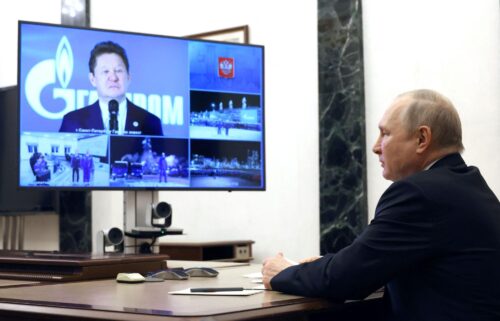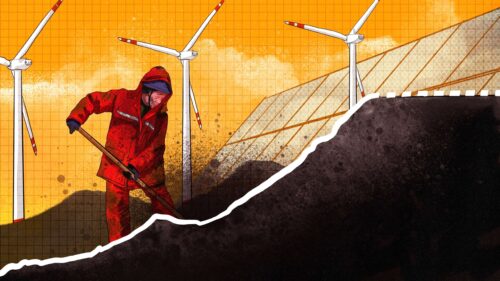Trina Solar’s plans for global dominance
Trina Solar is making billions selling solar panels abroad, and spending billions in China to increase production and secure access to vital raw materials.

Last week, RE+, the largest exhibition in North America for the clean energy industry, took place in Anaheim, California. One exhibitor was Trina Solar 天合光能, a leading Chinese photovoltaic (PV) company with a market capitalization of over 145 billion yuan (over $20 billion). The company’s display included 450 watt (W), 590 W, and 600 W solar panels for residential and commercial uses, as well as a huge 670 W solar panel, which reportedly aroused the interest of developers of power plants at the event.
China is the undisputed global leader in the PV industry, with companies like Trina Solar, LONGi Green Energy Technology 隆基绿能, and Sungrow Power Supply 阳光电源 leading the charge. According to the China Photovoltaic Industry Association, in 2021:
- China produced 506,000 tons of polysilicon, a key raw material of solar panels, accounting for more than three-quarters of global production.
- China’s production of silicon wafers, which capture the sun’s rays in solar panels, was about 407.2 gigawatts (GW), accounting for 98.1% of global production.
- China’s production of solar panels themselves was 181.8 GW, accounting for 82.3% of the global total.
The world’s solar panels are made in China
China’s leading PV companies all derive from 50% to 80% of their revenue from outside China. In 2021, China exported silicon wafers, cells and solar panels of $28.43 billion, and in the first half of 2022, exports of solar panels continued apace, amounting to 78.7 GW, an increase of 102% year-on-year.
China’s dominance in the solar supply chain is a constant source of scrutiny in other countries. In July, for example, Trina Solar’s U.S. subsidiary was sued by TotalEnergies for damages of $200 million. Chinese PV companies regularly face anti-dumping investigations, tariffs, and specific acts of legislation, such as when the Biden Administration authorized the U.S. Department of Energy in June this year to accelerate domestic production of five key energy technologies, including solar panels.
Nevertheless, according to a report on global PV supply chains released by the International Energy Agency (IEA) in July this year, China’s share in all the key manufacturing stages of solar panels currently exceeds 80%, and for key elements like polysilicon and wafers, China’s share is set to rise to more than 95% in the coming years.
Unsurprisingly, in the first half of this year, Trina Solar exported 18.05 GW of solar panels, and its overseas revenue expanded year-on-year by 71%. Over the same period, Trina Solar reported total revenue of 35.73 billion yuan ($5.17 billion), an increase of 77% year-on-year, and net profit of 1.27 billion yuan ($180 million), an increase of 79% year-on-year.
China news, weekly.
Sign up for The China Project’s weekly newsletter, our free roundup of the most important China stories.
Trina’s expansion plans
Trina is not resting on its laurels, and has been announcing ambitious plans to ensure the stability of its supply chains and its future growth.
On Friday last week, Trina Solar announced the latest of its capacity expansions: A six billion yuan ($841.64 million) investment in an industrial zone in Jiangsu Province to produce 15 GW of solar panels and a further 15 GW of batteries for solar panels. According to calculations by a Chinese news agency, so far this year, Trina Solar has invested 40 billion yuan ($5.61 billion) to expand raw material procurement and capacity expansion for industrial silicon, polysilicon, batteries, and component materials.
Earlier in September, Trina Solar announced the largest high-purity silicon purchasing agreement ever in China. From 2023 to 2026, the company will purchase around 70,000 tons of the raw material from CSG Holding 南玻A for 21.21 billion yuan ($2.97 billion).
- The expansion of solar energy capacity in China has contributed to the rapid increase in the domestic price of silicon, which reached 300,000 yuan ($42,082) per ton at the beginning of July.
- As a result, PV companies like Trina Solar have signed long-term purchasing agreements to lock in supply of the vital raw material.
- Since the start of this year, Tongwei Group 通威集团, for example, China’s leading supplier of high-purity crystalline silicon, has signed five major high-purity silicon sales contracts worth a total of 254 billion yuan ($37.65 billion), which far outstrips the company’s entire reported revenue in 2021 of 63.49 billion yuan ($9.41 billion).
In June, Trina Solar announced a new investment in an industrial zone in Xining, Qinghai Province, that will produce an annual output of 300,000 tons of industrial silicon, 150,000 tons of high-purity polysilicon, 35 GW of monocrystalline silicon, and 10 GW of solar panels. The company did not disclose the full investment amount, but a Chinese research firm estimated it to be as much as 30.37 billion yuan ($4.26 billion) in two phases.
In all, over the next five years, Trina Solar’s investments in raw material and capacity expansion projects could amount to as much as 70 billion yuan ($9.81 billion).






